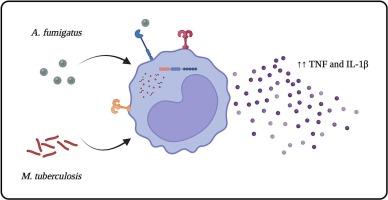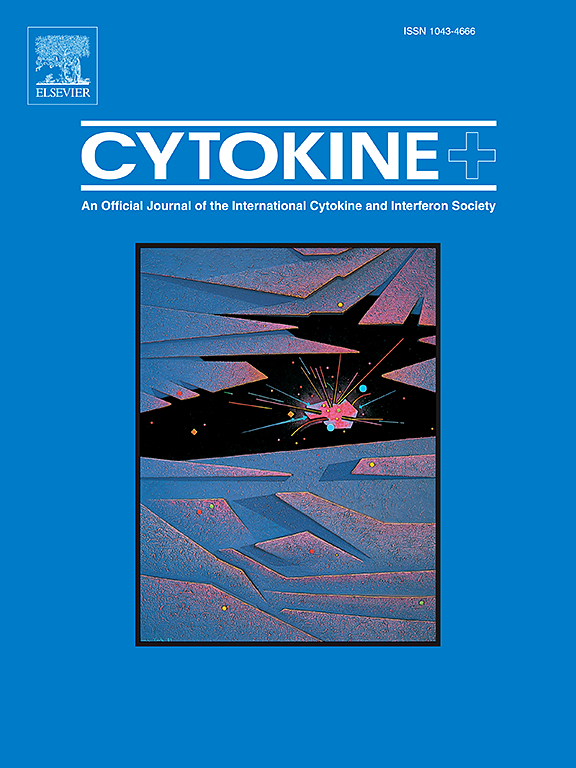Aspergillus fumigatus and Mycobacterium tuberculosis synergistically induce TNF and IL-1β via different pathways in human peripheral blood mononuclear cells
IF 3.7
3区 医学
Q2 BIOCHEMISTRY & MOLECULAR BIOLOGY
引用次数: 0
Abstract
Aspergillus fumigatus may cause infections in individuals with underlying lung damage, such as those with pulmonary tuberculosis (TB). Simultaneous exposure to A. fumigatus and Mycobacterium tuberculosis may worsen lung tissue damage, but the combined immune response to these pathogens has not yet been fully characterized.
Peripheral blood mononuclear cells (PBMCs) from healthy volunteers were stimulated with A. fumigatus conidia, M. tuberculosis H37Rv lysate, or both combined. TNF and IL-1β were measured from culture supernatants. The role of different pattern recognition receptors (PRRs) important for the recognition of both pathogens were explored by using PRR inhibitors and PBMCs from donors deficient in certain pathways.
A. fumigatus and M. tuberculosis synergistically induced TNF and IL-1β release by PBMCs, and this response was independent of TLR2 and dectin-1. We found that the synergy is regulated through distinct intracellular pathways. The activation of the intracellular receptor NOD2 by M. tuberculosis and NADPH oxidase complex-dependent ROS production triggered by A. fumigatus mediate TNF but not IL-1β synergy.
Together, these findings indicate that A. fumigatus and M. tuberculosis jointly exacerbate proinflammatory responses. This may help to explain the persistent inflammation and immunopathology observed in patients with concurrent TB and aspergillosis.

烟曲霉和结核分枝杆菌通过不同途径协同诱导人外周血单核细胞TNF和IL-1β
烟曲霉可引起潜在肺损伤的个体感染,如肺结核患者。同时暴露于烟曲霉和结核分枝杆菌可能会加重肺组织损伤,但对这些病原体的联合免疫反应尚未得到充分表征。用烟曲霉分生孢子菌、结核分枝杆菌H37Rv裂解液或两者联合刺激健康志愿者外周血单个核细胞。从培养上清液中检测TNF和IL-1β。通过使用PRR抑制剂和来自某些途径缺乏的供体的pbmc,研究了不同模式识别受体(PRRs)在识别两种病原体中的重要作用。烟曲霉和结核分枝杆菌协同诱导PBMCs释放TNF和IL-1β,且该反应不依赖于TLR2和dectin-1。我们发现协同作用是通过不同的细胞内途径调节的。结核分枝杆菌对细胞内受体NOD2的激活和烟曲霉引发的NADPH氧化酶复合物依赖性ROS的产生介导TNF,但不介导IL-1β协同作用。总之,这些发现表明烟曲霉和结核分枝杆菌共同加剧了促炎反应。这可能有助于解释结核和曲霉病并发患者的持续炎症和免疫病理。
本文章由计算机程序翻译,如有差异,请以英文原文为准。
求助全文
约1分钟内获得全文
求助全文
来源期刊

Cytokine
医学-免疫学
CiteScore
7.60
自引率
2.60%
发文量
262
审稿时长
48 days
期刊介绍:
The journal Cytokine has an open access mirror journal Cytokine: X, sharing the same aims and scope, editorial team, submission system and rigorous peer review.
* Devoted exclusively to the study of the molecular biology, genetics, biochemistry, immunology, genome-wide association studies, pathobiology, diagnostic and clinical applications of all known interleukins, hematopoietic factors, growth factors, cytotoxins, interferons, new cytokines, and chemokines, Cytokine provides comprehensive coverage of cytokines and their mechanisms of actions, 12 times a year by publishing original high quality refereed scientific papers from prominent investigators in both the academic and industrial sectors.
We will publish 3 major types of manuscripts:
1) Original manuscripts describing research results.
2) Basic and clinical reviews describing cytokine actions and regulation.
3) Short commentaries/perspectives on recently published aspects of cytokines, pathogenesis and clinical results.
 求助内容:
求助内容: 应助结果提醒方式:
应助结果提醒方式:


